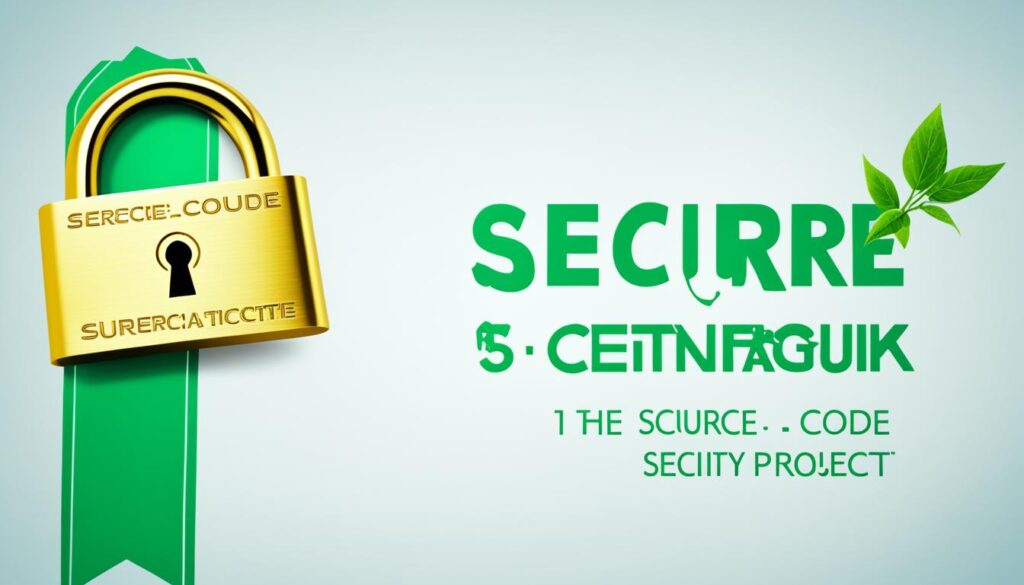In a digital era where over 90% of IT organizations rely on open-source software, achieving impenetrable software security in development is no longer optional—it’s essential. While open source code ignites innovation and collaboration, it also amplifies the need for safeguarding measures. Code signing for open source projects represents a crucial shield in the battle against code tampering and malicious exploits. This digital verification serves as the gatekeeper, affirming that the code users download and deploy is trusted and untampered with. With the rampant increase in cybersecurity threats, open source code signing has transitioned from a best practice to a non-negotiable standard.
The pursuit of software security for open source ventures beyond traditional boundaries, delving into the realms of digital signatures for open source. These signatures act as a binding seal on the software’s integrity, offering end-users and developers alike confidence in the legitimacy of the open-source projects they leverage. Harnessing digital signatures is a pledge of security, a silent sentinel safeguarding the collaborative efforts that fuel modern software infrastructure.
As the software landscape evolves, code signing stands as a testament to enduring reliance on community-led projects. Join us on a journey to decode the intricacies of code signing; a voyage towards understanding its imperativeness, the unexpected challenges it addresses, and the community trust it harbors for the multifaceted ecosystem of open-source software.
Key Takeaways
- Code signing is non-negotiable in today’s security-conscious tech environment.
- Open-source projects are especially vulnerable and require stringent security measures.
- Digital signatures give assurance of code integrity and origin to users and developers.
- Implementing code signing fortifies trust, a core value in the open-source community.
- The rise in cybersecurity threats underpins the urgency for robust code signing systems.
Introduction to Code Signing
Understanding the foundational elements of secure code signing practices is essential for any developer or organization involved in open source software. Code signing offers a layer of security that verifies the integrity and authenticity of software, and this is particularly crucial for the highly collaborative and open nature of open source projects.
Maintaining rigorous open source security protocols is fundamental to protecting collaborative software from unauthorized modifications and potential vulnerabilities. As developers worldwide contribute to this growing ecosystem, establishing and following the best practices for code signing is not just a recommendation—it’s a prerequisite for building and preserving trust. This trust is dual-faceted; it strengthens confidence among developers and reassures end-users of the software’s reliability.
By using digital certificates to affirm the origin and integrity of code, open source software maintains its ethos of transparency while ensuring user security.
- Endorse the use of digital certificates to confirm code authenticity.
- Implement code signing as part of a broader security strategy.
- Evolve code signing measures as open source projects develop.
Whether it is a small utility tool or a sprawling software framework, integrating secure code signing into the developmental lifecycle of open source projects shields both creators and users, reinforcing the bedrock of trust that open source communities are built upon.

- Obtain a digital certificate from a trusted certificate authority.
- Sign the code with a private key linked to the obtained certificate.
- Verify the signed code before deployment to ensure integrity.
Thus, as open source becomes increasingly interwoven into the fabric of digital infrastructure, the importance of code signing surges, not just as a technicality, but as a pillar of open source credibility and assurance.
Understanding Open Source Software Security
When navigating the realm of open-source software, security remains at the forefront of concerns for developers and end-users alike. As open-source initiatives grow in popularity and importance, the communal nature of these projects often leads to unique security challenges that must be addressed to maintain the integrity and trust which are foundational to these collaborative efforts.
Why Security in Open Source Matters
The collaborative essence of open-source projects, while fostering innovation and broad participation, also opens the door to potential security threats. Like the open edits in a shared Google document utilized in an educational setting, the open-source code is accessible to contributions from numerous individuals, thereby increasing the likelihood of vulnerabilities. Addressing these security issues is critical as they can result in significant repercussions for a vast number of users who depend on open-source software for their daily operations.
Common Vulnerabilities in Open Source Projects
Vulnerabilities within open-source projects often arise from insufficient control mechanisms and the diverse nature of contributor submissions. Without comprehensive security measures in place, these vulnerabilities could potentially be exploited by malicious actors to compromise the software and, by extension, its users. Regularly monitoring and updating projects for security flaws is essential, yet integrating robust tools into the development process can greatly enhance this effort.
Role of Code Signing in Mitigating Risks
Code signing is a vital measure in fortifying open-source software against unauthorized and potentially harmful modifications. By employing code signing certificates, maintainers and contributors authentically confirm their contributions. Advanced code signing tools are part and parcel of a secure software development ecosystem, ensuring that each change merged into the main codebase is verified, thus preserving the integrity of the software. Such a certification process reassures all stakeholders that the open-source software they are interacting with is secure and genuine.
Emphasizing the importance of security in the interconnected world of software development, code signing certificates stand as sentinels guarding against the unauthorized manipulation of the code. In this context, the call for secure software development is not just a trend but a necessity, ensuring that open-source projects can thrive in an environment where safety and reliability are not compromised.

The Importance of Code Signing for Open Source Projects
In today’s digital landscape, where open source software (OSS) is ubiquitous and integral to technology advancement, software security for open source stands at the forefront of developer concerns. A critical aspect of this security is code signing for open source projects, which not only solicits trust but also establishes a framework for verified software distribution.

Establishing Trust Within the Developer Community
Open source projects thrive on their communities. Contributors, ranging from novice coders to experienced software architects, rely on code signing as the hallmark of trust and integrity. The digital signatures entailed in code signing allow for a verifiable chain of custody, ensuring that the code delivered is the code written, untampered by third parties.
Protecting End-Users from Malware
The risk of malware and other malignant exploits presents a very real threat to end-users. Code signing acts as a formidable barricade against these dangers. It’s more than just a security protocol; it’s a commitment to user safety—a pledge that developers make, certifying that any piece of software, patched or updated, is free of malicious code. Therefore, whether developers or end-users, all parties gain peace of mind knowing that the sanctity of the open source software they use and trust is upheld.
Obtaining a Code Signing Certificate for Open Source Projects
For open source projects, the integrity and security of the code is paramount. That’s where digital signatures for open source come into play. These are facilitated by code signing certificates, which serve as a stamp of legitimacy and a means to foster user trust. Below is a guide outlining the process for obtaining a code signing certificate for your open source initiatives, ensuring your project adheres to the best practices of open source code signing.

Begin by establishing the credibility of your project or your identity as an individual developer. The verification process may vary depending on the certificate authority, but typically involves providing organizational information and validating your authority to act on behalf of the project.
Choosing the Right Certification Authority
- Look for certification authorities that recognize the unique needs of open source projects.
- Consider authorities offering discounts or special terms for open source initiatives.
Applying for a Certificate
- Complete the application with the necessary details about your project.
- Submit documentation that proves the open source nature of your project, if required.
“Embedding digital signatures in your open source project is essential for demonstrating code authenticity and maintaining a secure environment for contributors and users alike.”
Once you have acquired your certificate, the next step is to implement the signing process into your project’s development workflow. Whether it’s through automated build systems or a manual process, your code signing certificates will serve to assert the integrity and origin of your code base.
Key Benefits of Code Signing Certificates
| Benefit | Description |
|---|---|
| Authenticity | Confirms the identity of the source of the code to end-users and contributors. |
| Integrity | Ensure the code has not been tampered with since the signing process. |
| Trust | Builds confidence in the security and reliability of the open source project. |
By acquiring and judiciously using a code signing certificate, your open source project demonstrates a commitment to security and trustworthiness, essential elements in today’s software development landscape.
Implementing Code Signing in Your Project
As the digital landscape evolves, the importance of securing open source projects has never been higher. Implementing secure code signing practices is a step in the right direction for enhancing your project’s integrity and trustworthiness. Let’s walk through how to properly prepare your project for code signing, select the most suitable tools, and follow a step-by-step approach for best practices.
Preparing Your Open Source Project for Code Signing
Before introducing code signing to your project, it’s essential to establish a baseline protocol. This protocol should outline the code signing process and the guidelines to maintain consistency throughout the project. Furthermore, your documentation should emphasize these protocols to ensure clarity among contributors. By setting these ground rules, you pave the way for a transparent and systematic approach to secure your open-source contributions.
Choosing the Right Tools for Code Signing
Selecting the appropriate code signing tools is an important step that benefits the project in the long term. Popular choices include Fastlane and Semaphore, which have established themselves in continuous integration workflows. These tools not only facilitate the code signing process but also provide stability and reliability to the development and deployment stages, aligning perfectly with open source security protocols.
Step-by-Step Process for Secure Code Signing Practices
The execution of secure code signing practices involves a meticulous, step-by-step process. It begins with the creation and management of digital certificates and provisioning profiles, extends to securing repository connections, and concludes with ensuring developer compliance to security standards. To help you envision this, consider a well-structured routine where every contribution undergoes verification before integration, akin to a finely tuned assembly line where quality control is paramount.
It is crucial to be diligent about these practices to protect your project from security breaches and unauthorized access. By instituting a robust code signing strategy, you safeguard your open source project against any compromise that could undermine users’ trust or project credibility.
Navigating the Digital Signature Terrain
As open-source projects continue to shape the foundation of modern software development, the role of digital signatures becomes increasingly prominent. These cryptographic mechanisms are not just technical formalities; they are pillars of trust and security in the sprawling ecosystem of open source. By aligning with secure code signing practices, developers affirm the authenticity and integrity of their work, delivering a clear message of reliability to users worldwide.

Understanding Digital Signatures and Their Relevance
Digital signatures are akin to tamper-evident seals on software, offering proof that the content is unaltered and verifiable. In the context of open-source projects, they ensure that the distributed code is what the developers intended to release, untainted by malicious intent or unauthorized changes. These signatures are essential for maintaining the delicate balance between openness and security in software that powers countless applications.
Different Types of Digital Certificates
Certificate types vary based on project needs and assurance levels:
| Certificate Type | Assurance Level | Intended Use |
|---|---|---|
| Standard Code Signing Certificate | Basic | Individual developers, Small-scale projects |
| Extended Validation (EV) Code Signing Certificate | High | Enterprise-level projects, High-reputation requirement |
This cryptographic landscape provides flexible options for project maintainers and contributors. Each certificate type offers a degree of digital signature validation that matches different scopes and scales of open-source endeavors, from solo developers working on niche tools to multinational organizations steering large-scale software solutions. Understanding these options is crucial for selecting an appropriate level of security when engaging in code signing for open source projects.
Best Practices for Code Signing Open Source Software
Embracing the best practices for code signing is pivotal for maintaining the integrity and trust of open source software. In this age of omnipresent cybersecurity threats, secure software development is more than a protocol—it’s a mandate. Below, we delve into the key practices that uphold the security tenets and optimize the effectiveness of code signing certificates.
- Securely manage private keys to prevent unauthorized use and potential compromise.
- Regularly audit and track certificate use to promptly identify and address any irregularities.
- Leverage a reliable timestamping service to validate the time of signing and extend the trust beyond certificate expiration.
- Ensure minimal exposure of code signing credentials to reduce the risk surface.
For a more granular look, the table below delineates these practices.
| Code Signing Best Practice | Benefits | Implementation |
|---|---|---|
| Private Key Management | Prevents unauthorized usage and maintains code integrity | Use HSMs or PFX files with strong passwords |
| Certificate Audits | Ensures legitimate use and availability | Regularly scheduled audits with documented reviews |
| Timestamping | Preserves trust post-certificate expiration | Integrate with a secure and reputable timestamping server |
| Credential Exposure Reduction | Minimizes potential attack vectors | Limit access through role-based permissions; minimal-duration checkout |
Implementing a comprehensive and meticulous security framework for code signing is not just about following a procedure; it’s about conveying a strong commitment to security that resonates with every user and contributor within the open-source universe.
Code signing is the linchpin of software authenticity and integrity. Every digitally signed piece of code serves as a testament to secure and responsible development.
In summation, the adherence to best practices for code signing must be considered the backbone of any secure software development life cycle, particularly within the collaborative and dynamic open source environment. It is an investment in the project’s longevity and credibility and, by extension, an investment in the collective trust of the communities it serves.
Code Signing Tools and Technologies
As open source software continues to be integrated into vital systems worldwide, it is imperative for developers to utilize code signing tools to maintain authenticity and integrity of their code. The evolution of these tools has provided various choices tailored to specific project requirements, ensuring that open source code signing remains a secure and streamlined process.
Review of Common Code Signing Tools
Among the plethora of tools available, Fastlane Match has gained popularity for iOS projects by automating certificate and provisioning profile management. Conversely, signtool is a staple for Windows applications, offering developers a versatile means to apply digital signatures. These tools are essential components in the implementation of secure code signing practices, helping maintain the sanctity of code against unauthorized alterations.
Integrating Code Signing into Continuous Integration Systems
Incorporating code signing into continuous integration systems like Semaphore has significantly improved the efficiency of the software development lifecycle. This integration propels the secure and automated delivery of open source software, thereby fortifying the trust and reliability that users place in open source solutions. The automation afforded by continuous integration systems ensures that code signing is consistently applied according to best practices, providing assurance of the software’s security posture.
Below is a comparison of some widely-used code signing tools and their respective features, helping you make an informed decision for your project’s needs:
| Tool | Platform | Key Features | Integration |
|---|---|---|---|
| Fastlane Match | iOS | Automates certificate and provisioning profile management | Integrates with CI like Jenkins, CircleCI |
| Signtool | Windows | Embeds digital signatures; timestamping support | Can be used with various CI/CD environments |
| Semaphore | Multi-platform | Automates pipelines, including code signing steps | Native integration for a smooth CI/CD process |
Each tool serves to enhance the open source coding experience, providing robust solutions for maintaining code integrity and adhering to stringent security protocols.
By leveraging these technologies, developers can place greater focus on innovation and collaboration, confident in the knowledge that their open source contributions are protected and authenticated. Embracing these tools is not merely a suggestion but a cornerstone of responsible software development in today’s digital landscape.
Community Perspectives on Secure Software Development
The discourse on software security for open source projects is enriched by the shared experiences and initiatives of the development community. Understanding how developers implement code signing for open source projects sheds light on secure code signing practices and inspires others to follow suit.
Case Studies: Open Source Projects Doing It Right
Delving into open source projects that have embraced advanced security measures is crucial for evolving the state of software safety. These projects serve as beacons, leading the way by integrating stringent code signing protocols, thereby enhancing user trust and establishing a benchmark for others.
Developer Insights on Secure Code Signing Practices
Personal accounts from developers elucidate the nuances of secure software development within the open source realm. From selecting the right code signing tools to navigating the complexities of certificate management, developer testimonies provide invaluable perspectives.
- Emphasizing the importance of maintaining a secure environment for private keys.
- Discussing the benefits of using automated tools to streamline the code signing process.
- Sharing strategies for overcoming challenges related to code signing in a collaborative setting.
These insights not only enhance our understanding of practical applications but also strengthen the collaborative foundation that open source is built upon.
Conclusion
The journey through the nuances of code signing for open-source projects brings us to a pivotal culmination. It’s clear that balancing the principle of transparency inherent in the open-source philosophy with the imperatives of secure software development is essential. As the digital sphere becomes more interconnected and reliant on open-source software, the meticulous approach to open source security protocols and the careful examination and utility of digital signatures for open source have never been more vital. These protocols and tools are not merely accessories but rather cornerstones of trust and security in the evolving landscape of open-source software.
The importance of embracing secure code signing practices cannot be overstated. While these practices serve as a declaration of integrity and origin, they simultaneously protect the global community from potential vulnerabilities. A rigorous implementation of established security measures and the leveraging of state-of-the-art code signing tools ensure that open-source projects can continue to flourish, unperturbed by threats that could compromise their credibility and the safety of their users.
In essence, the open-source community is entrusted with a mission that goes beyond code creation. It is a commitment to upholding standards that champion secure software development—a commitment to fostering an environment where innovation is congruent with security. As more projects adopt these imperatives, the collective effort will solidify the trust in open-source software, nurturing an ecosystem where developers and users alike can collaborate and innovate with confidence.
FAQ
Why is code signing important for open source projects?
Code signing is important for open source projects because it ensures the integrity and authenticity of the code. It verifies the legitimacy of the code source and confirms that the software has not been tampered with after signing. This is crucial for maintaining trust within the developer community and protecting end-users from malware.
What are the common vulnerabilities in open source projects?
Common vulnerabilities in open source projects usually stem from a lack of stringent controls and variations in contributor inputs which can lead to security gaps. These can be exploited by malicious actors if not properly managed and secured through practices like code signing.
How does code signing mitigate risks in open source software?
Code signing mitigates risks by ensuring that any changes to the code are made by authorized maintainers. It uses digital certificates to indicate that code is legitimate and that it hasn’t been modified by an unauthorized party, thus preventing the introduction of malware or other malicious alterations.
What steps are involved in obtaining a code signing certificate for an open source project?
To obtain a code signing certificate for an open source project, you must first prove the credibility of your project or yourself as a requester. Then, you align with a certification authority that issues the certificates—often with special considerations for open source projects. Once obtained, you can embed digital signatures into your software.
What are the best practices for code signing open source software?
Best practices for code signing open source software include maintaining private keys in a secure environment, using a reliable timestamping service, regularly reviewing and updating certificates, minimizing the exposure of code signing credentials, and conducting audits to monitor certificate usage.
Which tools can be used for code signing in an open source project?
Various tools can be used for code signing in an open source project, including Fastlane and Semaphore for continuous integration, Fastlane Match for iOS projects, signtool for Windows applications, and more, depending on the specific requirements of the project.
Can you explain digital signatures and their relevance to open source security?
Digital signatures are a form of electronic verification of authenticity and integrity of code. They are crucial for open source security as they confirm that the code is originally from a trusted source and has not been altered, helping to maintain software reliability and user trust.
What are the different types of digital certificates used for code signing?
There are standard code signing certificates, which are adequate for individual developers and small projects. Then there are Extended Validation (EV) certificates, which provide a higher level of assurance and are instantly recognized by security services like Windows SmartScreen, often favored by enterprise-level projects.
How do open-source projects integrate code signing into continuous integration systems?
Open-source projects integrate code signing into continuous integration (CI) systems by automating the signing process within their CI pipeline, using tools that handle the creation, management, and storage of digital certificates and provisioning profiles, and ensuring secure connections to repositories.
What insights can be drawn from open source projects that have implemented secure code signing practices effectively?
Insights from open source projects with effective secure code signing practices include the importance of transparency, the need for strict adherence to security procedures, the efficacy of automating the code signing process, and the value of community feedback in continuously improving the security measures of the projects.





